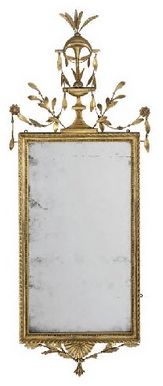Pier glass: Difference between revisions
Adding local short description: "Decorative wall mirror", overriding Wikidata description "decorative wall mirror between windows" |
No edit summary |
||
| Line 10: | Line 10: | ||
==Trumeau mirrors== |
==Trumeau mirrors== |
||
[[File:Amalienburg Spiegelsaal-2.jpg|upright|left|thumb|Large 18th-century [[Rococo]] pier glass in the [[Amalienburg|Amalienburg Pavilion]], [[Schloss Nymphenburg]].]] |
[[File:Amalienburg Spiegelsaal-2.jpg|upright|left|thumb|Large 18th-century [[Rococo]] pier glass in the [[Amalienburg|Amalienburg Pavilion]], [[Schloss Nymphenburg]].]] |
||
A trumeau mirror is a type of wall mirror originally manufactured in France in the later 18th century. It takes its name from the French word ''[[wikt:trumeau|trumeau]]'', which designates the space between windows. Such a mirror, usually rectangular, could also hang above an [[overmantel]]. A decorative carved or painted scene was the prominent characteristic, and could dominate the actual mirror.<ref>{{cite book|author=Mark Hinchman|title=The Fairchild Books Dictionary of Interior Design|url=https://books.google.com/books?id=X3FjAgAAQBAJ&pg=PA193|date=2 January 2014|publisher=A&C Black|isbn=978-1-60901-534-3|page=193}}</ref> |
A trumeau mirror is a type of wall mirror originally manufactured in France in the later [[Timeline of French history|18th century]]. It takes its name from the French word ''[[wikt:trumeau|trumeau]]'', which designates the space between windows. Such a mirror, usually rectangular, could also hang above an [[overmantel]]. A decorative carved or painted scene was the prominent characteristic, and could dominate the actual mirror.<ref>{{cite book|author=Mark Hinchman|title=The Fairchild Books Dictionary of Interior Design|url=https://books.google.com/books?id=X3FjAgAAQBAJ&pg=PA193|date=2 January 2014|publisher=A&C Black|isbn=978-1-60901-534-3|page=193}}</ref> |
||
==Notes== |
==Notes== |
||
Revision as of 19:29, 31 May 2024

A pier glass or trumeau mirror is a mirror which is placed on a pier, i.e. a wall between two windows supporting an upper structure.[1]
It is therefore generally of a long and tall shape to fit the space. It may be as a hanging mirror or as mirrored glass affixed flush to the pier, in which case it is sometimes of the same shape and design as the windows themselves. This was a common decorating feature in the reception rooms of Neoclassical 18th-century houses.
A pier table or console table typically stood below the pier glass;[2] very often these were made as a matching set.
Trumeau mirrors

A trumeau mirror is a type of wall mirror originally manufactured in France in the later 18th century. It takes its name from the French word trumeau, which designates the space between windows. Such a mirror, usually rectangular, could also hang above an overmantel. A decorative carved or painted scene was the prominent characteristic, and could dominate the actual mirror.[3]
Notes
- ^ "Definition of Pier Glass by Merriam-Webster". Merriam-Webster. Retrieved 17 March 2017.
- ^ Ralph Edwards (1974). The Shorter Dictionary of English Furniture: From the Middle Ages to the Late Georgian Period. Country Life Books. p. 364. ISBN 0600430820.
- ^ Mark Hinchman (2 January 2014). The Fairchild Books Dictionary of Interior Design. A&C Black. p. 193. ISBN 978-1-60901-534-3.
